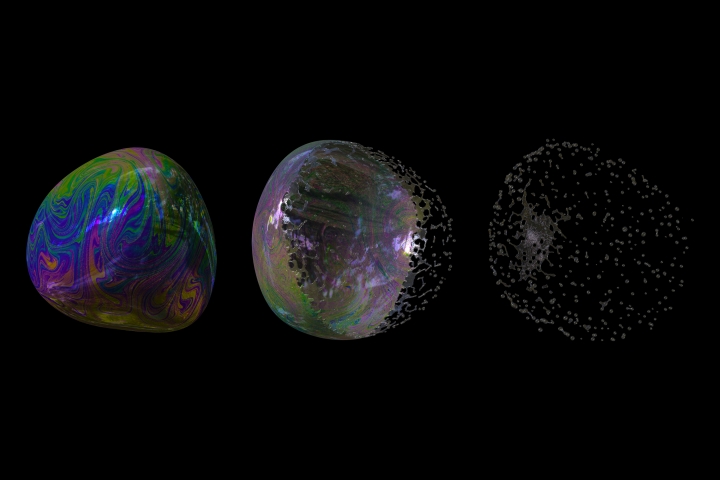Who among us hasn’t reached out to pop a bubble wafting through the air? At the merest touch, the bubble shatters in a shower of tiny droplets in about a millisecond. Capturing the details of this blink-and-you’ll-miss-it phenomenon takes sophisticated high-speed video.
Harder still is recreating it via computer animation while staying true to the physics of the pop, says Bo Zhu, assistant professor of computer science, an expert in physics-based animation, a core area of computer graphics research.
Fluid animation is Zhu’s particular area of expertise. He builds computational tools that can reproduce fluids—liquids, bubbles, foam, fire, and smoke—and how they transform and flow in a wide variety of physical settings.
His work has recently attracted two awards from the National Science Foundation—a $500,000 Faculty Early Career Development award and a $400,000 Computer and Information Science and Engineering grant, in support of his research. Both projects apply fluid simulation techniques to model and understand fluids in vastly different fields—human health and digital manufacturing.

“I have always been fascinated by the beauty and complexity of fluids,” says Zhu. He was particularly inspired by photographs taken by John Bush, Massachusetts Institute of Technology professor of applied mathematics. Bush’s pictures of bubbles and water striders were a stunning portfolio of surface tension and other fluid phenomena in action, which Zhu wanted to recreate virtually.
Computers crunch complicated numerical equations to simulate fluids on screen. The algorithms that power fluid animations have come a long way, but computer scientists like Zhu find innovative ways to refine them, making it possible to use less computational power to model fluids faster and with more accuracy and visual appeal.
Working with collaborators from Texas A&M University and the Beijing Film Academy, Zhu and graduate student Jinyuan Liu, Guarini ’24, proposed a novel approach to model the physics at the interface of solids and liquids. That’s where surface tension sets the rules, allowing dense objects to float if their shape is right.
In a departure from previous methods that only consider the physical interplay between solid and liquid, the researchers treat the system as a three-way interaction between solid, liquid, and a thin liquid membrane, which acts as a stand-in for the effects of surface tension.
What resulted were some of the most lifelike renditions of slowly sinking pushpins, floating maple leaves, cherries floating on water but drowning in milk, and a robotic strider walking on water.

Zhu’s research group also devised a new computational method to simulate how bubbles form and move, which was presented at SIGGRAPH 2021, an annual conference on computer graphics by the Association for Computer Machinery. Their latest results on the technique will be presented at this year’s conference in July.
Unlike previous methods that describe the thin surface of a bubble as a mesh of connected triangles, their technique treats the fluid as a collection of particles. “We can then apply and solve the relevant physical equations for every local point,” says Zhu. This, he says, allows the algorithm to handle shape changes more deftly and model bubbles that merge, split, or break.
Based on this particle representation, Mengdi Wang, Guarini ’25, and Yitong Deng, Guarini ’23, lead authors on the two SIGGRAPH papers, developed new simulation algorithms to model the vivid flow physics on bubbles. Aditya Prasad ’21 added realistic color to the shape-shifting bubbles by applying the optics of thin soap films to the simulation using a visual effects software. This work won Prasad a Made-At-Dartmouth prize.
“Besides creating visually interesting animations for scientific illustration, these modeling tools have a great relevance to public health research, especially, disease transmission,” says Zhu. Germs survive transmission by suspending in fluid forms, which can be just liquids, thin sheets, filaments, bubbles, foams, droplets, or aerosols. All of these exhibit complex shapes and dynamics.
By extending his bubble modeling technique, Zhu is working on designing computational tools that can simulate fluid phenomena that are related to human health and hygiene processes, such as sneezing mucus, splash plumes, and hand-washing foam, which have been out of reach for visual and scientific computing due to these complexities. What’s more, the animations would run on a regular laptop or desktop; researchers don’t have to invest in supercomputers to use them.
Modeling hygiene-related behaviors can help scientists develop a new understanding of many small-scale fluid phenomena—how a soap bubble bursts, how soap foams form in handwashing, and how droplets or aerosols are generated in a sneeze.
“What we know about the benefits of hand-washing or how coughs and sneezes carry germs are based on data collected from experiments or observations using high-speed cameras,” says Zhu. Developing computational methods to model these processes will open the doors to investigating the factors that affect them by playing around virtually with physical parameters such as airflow and masking. The more cumbersome physical experiments can be done to verify the hypotheses, says Zhu, speeding up the wheels of discovery.
Zhu is also putting computers to work on designing and optimizing devices like jet engines, hydraulic pumps, or medical devices, which use fluids in motion to perform specialized functions. Human engineers have traditionally relied on experience and established designed practices to craft them.
Developing computational tools that can learn these tricks of the trade can fuel innovation in energy efficiency, boost the functionality of soft robotic platforms, and enable the creation of next-generation prosthetics. “A large part of the design process is repeatedly tweaking parameters, often based on trial-and-error,” says Zhu. By automating this process, engineers can solve these design problems with a click of a button.

